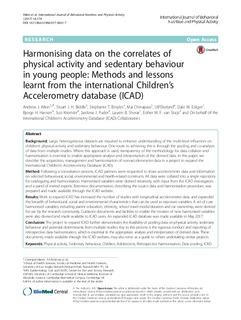| dc.contributor.author | Atkin, Andrew J. | |
| dc.contributor.author | Biddle, Stuart J. H. | |
| dc.contributor.author | Broyles, Stephanie T. | |
| dc.contributor.author | Chinapaw, Mai | |
| dc.contributor.author | Ekelund, Ulf | |
| dc.contributor.author | Esliger, Dale W. | |
| dc.contributor.author | Hansen, Bjørge Herman | |
| dc.contributor.author | Kriemler, Susi | |
| dc.contributor.author | Puder, Jardena J. | |
| dc.contributor.author | Sherar, Lauren B. | |
| dc.contributor.author | van Sluijs, Esther M.F. | |
| dc.contributor.author | Andersen, Lars Bo | |
| dc.contributor.author | Anderssen, Sigmund A. | |
| dc.contributor.author | Cardon, G. | |
| dc.contributor.author | Davey, R. | |
| dc.contributor.author | Hallal, P. | |
| dc.contributor.author | Janz, K. F. | |
| dc.contributor.author | Møller, N. | |
| dc.contributor.author | Molloy, L. | |
| dc.contributor.author | Page, A. | |
| dc.contributor.author | Pate, R. | |
| dc.contributor.author | Reilly, J. | |
| dc.contributor.author | Salmon, J. | |
| dc.contributor.author | Sardinha, L. B. | |
| dc.contributor.author | Timperio, A. | |
| dc.date.accessioned | 2018-03-23T19:19:13Z | |
| dc.date.available | 2018-03-23T19:19:13Z | |
| dc.date.created | 2018-02-08T13:50:21Z | |
| dc.date.issued | 2017 | |
| dc.identifier.citation | International Journal of Behavioral Nutrition and Physical Activity. 2017, 14, 174 | |
| dc.identifier.issn | 1479-5868 | |
| dc.identifier.uri | http://hdl.handle.net/11250/2492013 | |
| dc.description | This article is distributed under the terms of the Creative Commons Attribution 4.0 International License (http://creativecommons.org/licenses/by/4.0/), which permits unrestricted use, distribution, and reproduction in any medium, provided you give appropriate credit to the original author(s) and the source, provide a link to the Creative Commons license, and indicate if changes were made. The Creative Commons Public Domain Dedication waiver (http://creativecommons.org/publicdomain/zero/1.0/) applies to the data made available in this article, unless otherwise stated. | |
| dc.description.abstract | Background: Large, heterogeneous datasets are required to enhance understanding of the multi-level influences on children’s physical activity and sedentary behaviour. One route to achieving this is through the pooling and co-analysis of data from multiple studies. Where this approach is used, transparency of the methodology for data collation and harmonisation is essential to enable appropriate analysis and interpretation of the derived data. In this paper, we describe the acquisition, management and harmonisation of non-accelerometer data in a project to expand the International Children’s Accelerometry Database (ICAD). Method: Following a consultation process, ICAD partners were requested to share accelerometer data and information on selected behavioural, social, environmental and health-related constructs. All data were collated into a single repository for cataloguing and harmonisation. Harmonised variables were derived iteratively, with input from the ICAD investigators and a panel of invited experts. Extensive documentation, describing the source data and harmonisation procedure, was prepared and made available through the ICAD website. Results: Work to expand ICAD has increased the number of studies with longitudinal accelerometer data, and expanded the breadth of behavioural, social and environmental characteristics that can be used as exposure variables. A set of core harmonised variables, including parent education, ethnicity, school travel mode/duration and car ownership, were derived for use by the research community. Guidance documents and facilities to enable the creation of new harmonised variables were also devised and made available to ICAD users. An expanded ICAD database was made available in May 2017. Conclusion: The project to expand ICAD further demonstrates the feasibility of pooling data on physical activity, sedentary behaviour and potential determinants from multiple studies. Key to this process is the rigorous conduct and reporting of retrospective data harmonisation, which is essential to the appropriate analysis and interpretation of derived data. These documents, made available through the ICAD website, may also serve as a guide to others undertaking similar projects. | |
| dc.language.iso | eng | |
| dc.subject | physical activity | |
| dc.subject | sedentary behaviour | |
| dc.subject | children | |
| dc.subject | adolescents | |
| dc.subject | retrospective harmonisation | |
| dc.subject | data pooling | |
| dc.subject | ICAD | |
| dc.title | Harmonising data on the correlates of physical activity and sedentary behaviour in young people: Methods and lessons learnt from the international Children's Accelerometry database (ICAD) | |
| dc.type | Peer reviewed | |
| dc.type | Journal article | |
| dc.description.version | publishedVersion | |
| dc.rights.holder | © The Author(s). 2017 | |
| dc.source.volume | 14 | |
| dc.source.journal | International Journal of Behavioral Nutrition and Physical Activity | |
| dc.source.issue | 1 | |
| dc.identifier.doi | 10.1186/s12966-017-0631-7 | |
| dc.identifier.cristin | 1563256 | |
| dc.description.localcode | Seksjon for idrettsmedisinske fag / Department of Sport Medicine | |
| cristin.unitcode | 150,34,0,0 | |
| cristin.unitname | Seksjon for idrettsmedisinske fag | |
| cristin.ispublished | true | |
| cristin.fulltext | original | |
| cristin.qualitycode | 2 | |
